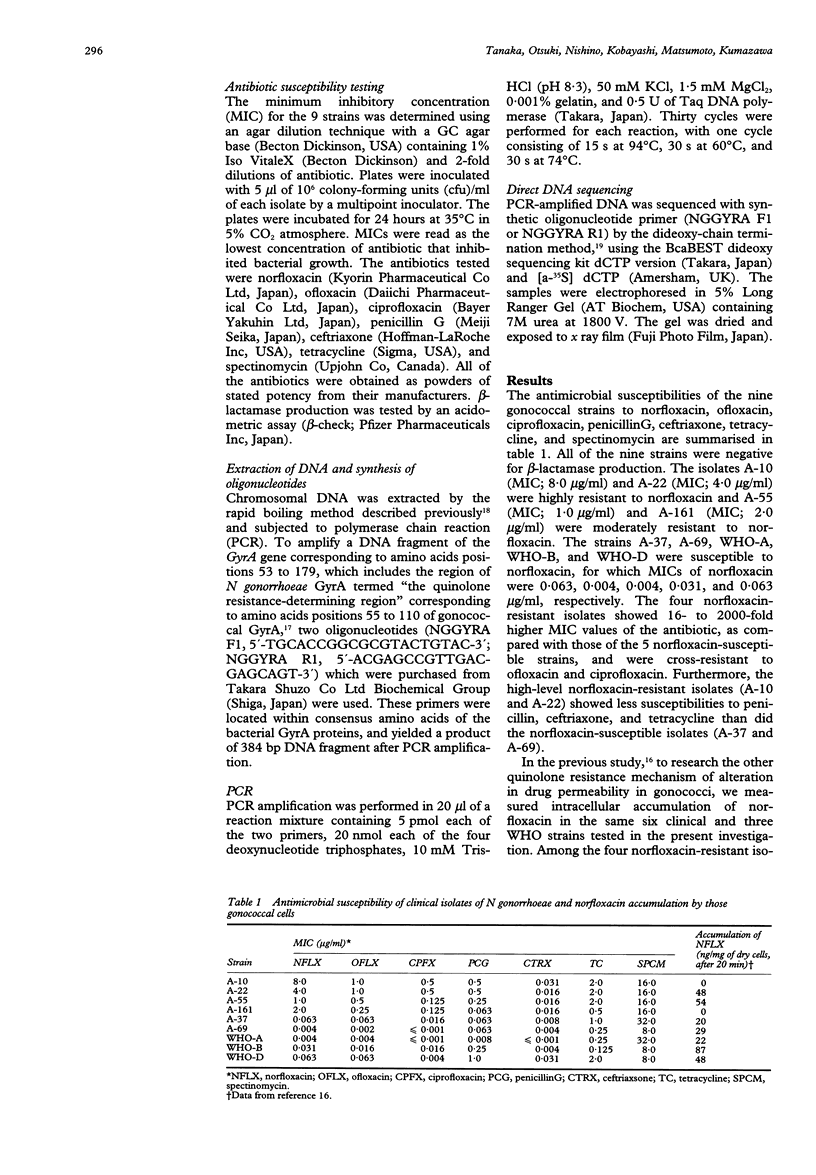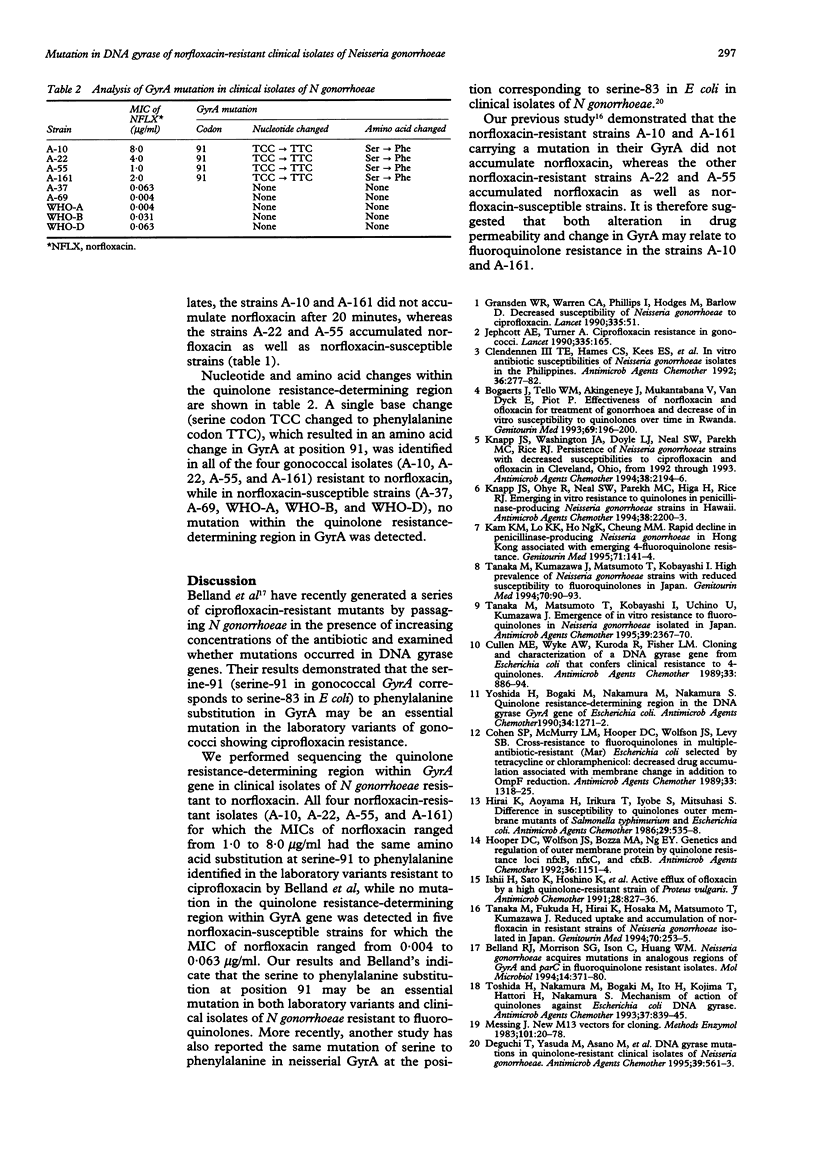Abstract
BACKGROUND AND OBJECTIVES: Recently a rapid decrease in the susceptibility of Neisseria gonorrhoeae isolates to fluoroquinolones has occurred and gonococcal fluoroquinolone resistance is now a significant problem in the treatment of gonorrhoea in Japan. Thus, in order to investigate the quinolone resistance mechanisms in clinical isolates of N gonorrhoeae we studied an alteration in the DNA gyrase subunit A (GyrA) which is well-known as a common mechanism of bacterial quinolone resistance. MATERIALS AND METHODS: Four clinical isolates of N gonorrhoeae resistant to norfloxacin and 5 strains susceptible to norfloxacin, including 2 clinical isolates and 3 WHO reference strains, were tested in this study. To identify mutations in the GyrA genes of gonococcal strains, polymerase chain reaction and direct DNA sequencing were performed. RESULTS: A single base change (serine codon TCC changed to phenylalanine codon TTC), which resulted in an amino acid change in GyrA at position 91, was identified in all 4 norfloxacin-resistant strains for which the MICs of norfloxacin ranged from 1.0 to 8.0 micrograms/ml, while no mutation within GyrA was detected in 5 norfloxacin-susceptible strains for which the MICs of norfloxacin ranged from 0.004 to 0.063 microgram/ml. CONCLUSIONS: The results from this study suggest that the serine-91 to phenylalanine substitution in GyrA is probably an essential mutation in fluoroquinolone resistance in clinical isolates of N gonorrhoeae.
Full text
PDF


Selected References
These references are in PubMed. This may not be the complete list of references from this article.
- Belland R. J., Morrison S. G., Ison C., Huang W. M. Neisseria gonorrhoeae acquires mutations in analogous regions of gyrA and parC in fluoroquinolone-resistant isolates. Mol Microbiol. 1994 Oct;14(2):371–380. doi: 10.1111/j.1365-2958.1994.tb01297.x. [DOI] [PubMed] [Google Scholar]
- Bogaerts J., Tello W. M., Akingeneye J., Mukantabana V., Van Dyck E., Piot P. Effectiveness of norfloxacin and ofloxacin for treatment of gonorrhoea and decrease of in vitro susceptibility to quinolones over time in Rwanda. Genitourin Med. 1993 Jun;69(3):196–200. doi: 10.1136/sti.69.3.196. [DOI] [PMC free article] [PubMed] [Google Scholar]
- Clendennen T. E., 3rd, Hames C. S., Kees E. S., Price F. C., Rueppel W. J., Andrada A. B., Espinosa G. E., Kabrerra G., Wignall F. S. In vitro antibiotic susceptibilities of Neisseria gonorrhoeae isolates in the Philippines. Antimicrob Agents Chemother. 1992 Feb;36(2):277–282. doi: 10.1128/aac.36.2.277. [DOI] [PMC free article] [PubMed] [Google Scholar]
- Cohen S. P., McMurry L. M., Hooper D. C., Wolfson J. S., Levy S. B. Cross-resistance to fluoroquinolones in multiple-antibiotic-resistant (Mar) Escherichia coli selected by tetracycline or chloramphenicol: decreased drug accumulation associated with membrane changes in addition to OmpF reduction. Antimicrob Agents Chemother. 1989 Aug;33(8):1318–1325. doi: 10.1128/aac.33.8.1318. [DOI] [PMC free article] [PubMed] [Google Scholar]
- Cullen M. E., Wyke A. W., Kuroda R., Fisher L. M. Cloning and characterization of a DNA gyrase A gene from Escherichia coli that confers clinical resistance to 4-quinolones. Antimicrob Agents Chemother. 1989 Jun;33(6):886–894. doi: 10.1128/aac.33.6.886. [DOI] [PMC free article] [PubMed] [Google Scholar]
- Deguchi T., Yasuda M., Asano M., Tada K., Iwata H., Komeda H., Ezaki T., Saito I., Kawada Y. DNA gyrase mutations in quinolone-resistant clinical isolates of Neisseria gonorrhoeae. Antimicrob Agents Chemother. 1995 Feb;39(2):561–563. doi: 10.1128/aac.39.2.561. [DOI] [PMC free article] [PubMed] [Google Scholar]
- Gransden W. R., Warren C. A., Phillips I., Hodges M., Barlow D. Decreased susceptibility of Neisseria gonorrhoeae to ciprofloxacin. Lancet. 1990 Jan 6;335(8680):51–51. doi: 10.1016/0140-6736(90)90177-7. [DOI] [PubMed] [Google Scholar]
- Hirai K., Aoyama H., Irikura T., Iyobe S., Mitsuhashi S. Differences in susceptibility to quinolones of outer membrane mutants of Salmonella typhimurium and Escherichia coli. Antimicrob Agents Chemother. 1986 Mar;29(3):535–538. doi: 10.1128/aac.29.3.535. [DOI] [PMC free article] [PubMed] [Google Scholar]
- Hooper D. C., Wolfson J. S., Bozza M. A., Ng E. Y. Genetics and regulation of outer membrane protein expression by quinolone resistance loci nfxB, nfxC, and cfxB. Antimicrob Agents Chemother. 1992 May;36(5):1151–1154. doi: 10.1128/aac.36.5.1151. [DOI] [PMC free article] [PubMed] [Google Scholar]
- Ishii H., Sato K., Hoshino K., Sato M., Yamaguchi A., Sawai T., Osada Y. Active efflux of ofloxacin by a highly quinolone-resistant strain of Proteus vulgaris. J Antimicrob Chemother. 1991 Dec;28(6):827–836. doi: 10.1093/jac/28.6.827. [DOI] [PubMed] [Google Scholar]
- Jephcott A. E., Turner A. Ciprofloxacin resistance in gonococci. Lancet. 1990 Jan 20;335(8682):165–165. doi: 10.1016/0140-6736(90)90035-4. [DOI] [PubMed] [Google Scholar]
- Kam K. M., Lo K. K., Ho N. K., Cheung M. M. Rapid decline in penicillinase-producing Neisseria gonorrhoeae in Hong Kong associated with emerging 4-fluoroquinolone resistance. Genitourin Med. 1995 Jun;71(3):141–144. doi: 10.1136/sti.71.3.141. [DOI] [PMC free article] [PubMed] [Google Scholar]
- Knapp J. S., Ohye R., Neal S. W., Parekh M. C., Higa H., Rice R. J. Emerging in vitro resistance to quinolones in penicillinase-producing Neisseria gonorrhoeae strains in Hawaii. Antimicrob Agents Chemother. 1994 Sep;38(9):2200–2203. doi: 10.1128/aac.38.9.2200. [DOI] [PMC free article] [PubMed] [Google Scholar]
- Knapp J. S., Washington J. A., Doyle L. J., Neal S. W., Parekh M. C., Rice R. J. Persistence of Neisseria gonorrhoeae strains with decreased susceptibilities to ciprofloxacin and ofloxacin in Cleveland, Ohio, from 1992 through 1993. Antimicrob Agents Chemother. 1994 Sep;38(9):2194–2196. doi: 10.1128/aac.38.9.2194. [DOI] [PMC free article] [PubMed] [Google Scholar]
- Messing J. New M13 vectors for cloning. Methods Enzymol. 1983;101:20–78. doi: 10.1016/0076-6879(83)01005-8. [DOI] [PubMed] [Google Scholar]
- Tanaka M., Fukuda H., Hirai K., Hosaka M., Matsumoto T., Kumazawa J. Reduced uptake and accumulation of norfloxacin in resistant strains of Neisseria gonorrhoeae isolated in Japan. Genitourin Med. 1994 Aug;70(4):253–255. doi: 10.1136/sti.70.4.253. [DOI] [PMC free article] [PubMed] [Google Scholar]
- Tanaka M., Kumazawa J., Matsumoto T., Kobayashi I. High prevalence of Neisseria gonorrhoeae strains with reduced susceptibility to fluoroquinolones in Japan. Genitourin Med. 1994 Apr;70(2):90–93. doi: 10.1136/sti.70.2.90. [DOI] [PMC free article] [PubMed] [Google Scholar]
- Tanaka M., Matsumoto T., Kobayashi I., Uchino U., Kumazawa J. Emergence of in vitro resistance to fluoroquinolones in Neisseria gonorrhoeae isolated in Japan. Antimicrob Agents Chemother. 1995 Oct;39(10):2367–2370. doi: 10.1128/aac.39.10.2367. [DOI] [PMC free article] [PubMed] [Google Scholar]
- Yoshida H., Nakamura M., Bogaki M., Ito H., Kojima T., Hattori H., Nakamura S. Mechanism of action of quinolones against Escherichia coli DNA gyrase. Antimicrob Agents Chemother. 1993 Apr;37(4):839–845. doi: 10.1128/aac.37.4.839. [DOI] [PMC free article] [PubMed] [Google Scholar]


